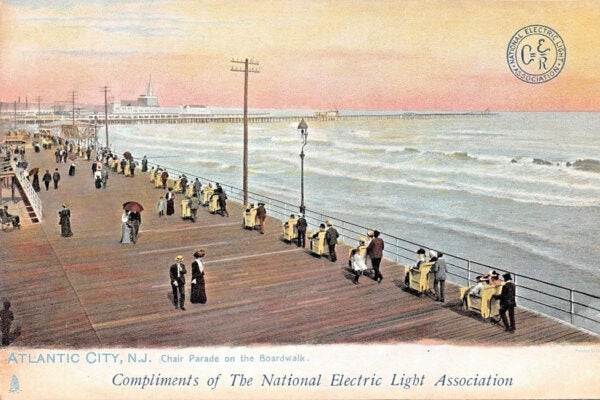Welcome to JSTOR Daily’s Planet-Conscious Weekly Summer Travel Series! Nearly 100 million Americans will take vacations in 2019, and summer is when many go globe-trotting. This summer JSTOR Daily will do so too—by researching the latest scholarship in sustainable travel and tourism. From electric cruise ships to biofuels-powered jets and from agritourism to sustainable ways of interacting with wildlife, we will investigate better, more sustainable ways to travel and interact with the world.
See that boat up there? That’s not just any boat sailing along a gorgeous Arctic landscape. It’s an electric boat quietly gliding along a pristine and fragile North Pole ecosystem without a loud engine puffing out polluting exhaust. And while this boat doesn’t yet sail today, it will be in 2021.
In May 2019, a Norwegian company SeaDream announced that it’s building a hybrid ship SeaDream Innovation that can switch between the traditional diesel mode and an electric battery-powered mode. In addition to the diesel engines, the yacht will carry a large battery pack of approximately 4 MWh, which will enable it to sail silently and without emissions for up to three hours without disturbing any surrounding wildlife. The company says that hybrid system will reduce both fuel consumption and harmful emissions. Built with a $1.8 million grant from Enova, an organization owned by the Norwegian Ministry of Climate and Environment, this new luxury mega-yacht will be able to sail to ecologically sensitive areas including the Norwegian fjords and along the ice edge toward the North Pole. The batteries also bring an added degree of safety, acting as fuel reserve if the yacht loses power.
SeaDream Innovation isn’t the only electric yacht being built today. Another Arctic-exploring hybrid-electric cruise vessel is getting ready to sail soon—The Brim Explorer. With a capacity of over 140 passengers, the catamaran would be able to sail on battery power for 10 hours and charge in ports overnight while switching to non-polluting biofuel when necessary. Workhorse electric ships are also on the horizon. Recently, the Port of Oslo decided to replace its current diesel-burning trash-collecting vessel with an electric one, which has already been commissioned.
The electric ships seem to be the latest milestone in the planet-conscious ecologically sustainable approach to travel and shipping, but the idea is over 100 years old. Engineers dreamed up and built the first electrically powered yachts in the 19th century. In the late 1800s, steam and electric boats were considered equally promising technologies. Moreover, some sailing enthusiasts were worried that these new technologies would eliminate wind sailing entirely, and make that skill and pleasure a thing of the past. On the brink of the 20th century, electric-powered boats were making great strides. They could be refueled at changing stations in ports and engineers were working on supplying them with auxiliary battery power to carry at sea. A 1908 Scientific American article covered a yacht “Cascapedia” that was built to carry an auxiliary power unit known as the Kilowatt, which enabled the yacht to operate for 100 hours, recharging it about a dozen times. And it would “make it independent of shore charging stations.”
Weekly Digest
The concept of hybrid oil-electric engines, similar to those SeaDream will rely on, also took hold at that time. Another Scientific American article introduced the first yacht to be equipped with a hybrid engine: “The yacht ‘Elfay,’ which went into commission in January, 1920, will probably occupy an important niche in the history of Marine engineering, for she is the first to be equipped with it.” The article described the yacht’s hybrid propulsion in great detail, noting the inner workings of the engine, power generators and controls. Although Elfay’s electric generator ran on oil, engineers believed at the time that such hybrid engines would “eventually prove the most satisfactory and efficient method of propelling ships.”
These electric boats’ past course was diverted by the fossil fuel engines, but today the engineers are rediscovering that same wisdom. A hundred years later, electric yachts and cruise ships are once again sailing into the landscapes—and particularly into the ecologically fragile ones.







